Magnetic Effect of Current
Question 1. Three straight wires parallel to each other carry the same steady current I in the same direction. They are placed perpendicular to the plane of the paper, as shown in the figure. The magnitude of the force per unit length on the middle wire B is given by
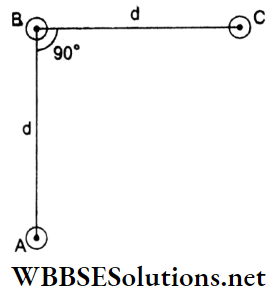
- \(\frac{\mu_0 I^2}{2 \pi d}\)
- \(\frac{2 \mu_0 I^2}{\pi d}\)
- \(\frac{\mu_0 I^2}{\sqrt{2} \pi d}\)
- \(\frac{\sqrt{2} \mu_0 I^2}{\pi d}\)
Answer: 3. \(\frac{\mu_0 I^2}{\sqrt{2} \pi d}\)
Like currents attract, so the forces acting on the middle wire are equal in magnitude \(\left(f=\frac{\mu_0 I^2}{2 \pi d}\right)\)and mutually perpendicular. Hence, the net force per unit length is \(\sqrt{2} f=\frac{\mu_0 I^2}{\sqrt{2} \pi d}\).

Question 2. A long straight wire of radius carries a steady current I. The current is uniformly, distributed over its cross-section. The ratio of the magnetic fields B and B’ radial distances \(\frac{a}{2}\) and 2a respectively from the axis of the wire is
- \(\frac{1}{2}\)
- 1
- 4
- \(\frac{1}{4}\)
Answer: 2. 1
Currentper unit area of cross section = \(\frac{I}{\pi a^2}\).
According to Ampere’s circuital law, at r = \(\frac{a}{2}\),
⇒ \(B=\frac{\mu_0}{2 \pi \frac{a}{2}}\left[\frac{I}{\pi a^2} \cdot \pi\left(\frac{a}{2}\right)^2\right]=\frac{\mu_0 I}{4 \pi a}\)
At r = 2a B’ = \(\frac{\mu_0}{2 \pi(2 a)} I=\frac{\mu_0 I}{4 \pi a}\)
∴ B: B’ = 1.
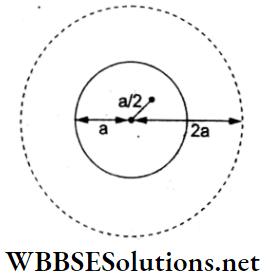
“mcq on magnetic effect of electric current “
Question 3. A 250-tum rectangular coil of length 2.1 cm and width 1.25 cm carries a steady current of 85μA and is subjected to a magnetic field of strength 0.85 T. The work done for rotating the coil by 180° against the torque is
- 1.5pJ
- 4.55pJ
- 9.5pJ
- 2.3pJ
Answer: 3. 9.5pJ
Given,N = 250, l = 2.1 cm, b =1.25 cm, I = 85 nA, B= 0.85 T, θ =180°.
The magnetic moment of the coil is
m = NAI = (250)(2.1 x1.25 x 10-4 m2 )(85 x 10-6 A).
Work done for rotation through 180° is
W = mB (1- cos θ)= mB (l- cos 180°)= 2mB
⇒ 2(250)(2.1 x 1.25 x 10-4 m2)(85 x 10-6 A)(0.85 T)
∴ 9.48 x 10-6 J = 9.5 nJ.
Read And Learn Also NEET Physics Multiple Choice Question and Answers
Question 4. A circular loop of wire and a long straight wire carry currents I1 and I2 respectively as shown in the figure. Assuming that these are coplanar, the magnetic field at the center of the circular loop will be zero when the separation H is
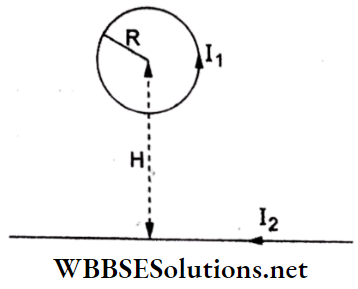
- \(\frac{I_1 R}{\pi I_2}\)
- \(\frac{I_2 R}{\pi I_1}\)
- \(\frac{\pi I_2 R}{I_1}\)
- \(\frac{\pi I_1 R}{I_2}\)
Answer: 2. \(\frac{I_2 R}{\pi I_1}\)
The magnetic field at the center of the circular coil due to its own current is \(B_1=\frac{\mu_0 I_1}{2 R}\) directed normally outward. The magnetic field at the center of the circular loop due to the straight current is \(B_2=\frac{\mu_0 I_2}{2 \pi H}\) directed normally inward.
For the magnetic field at the center to be zero,
∴ \(\frac{\mu_0 I_2}{2 \pi H}=\frac{\mu_0 I_1}{2 R} \Rightarrow H=\frac{I_2 R}{\pi I_1}\).
Question 5. The ratio of the magnetic field on the axis of a current-carrying circular coil of radius and at a distance x from the center of the coil to the magnetic field at its center will be
- \(\left(1+\frac{x^2}{a}\right)^{-3 / 2}\)
- \(\left(1+\frac{a^2}{x^2}\right)^{-1 / 2}\)
- \(\left(1+\frac{a^2}{x^2}\right)^{-2}\)
- \(\left(1+\frac{a^2}{x^2}\right)^{-3}\)
Answer: 1. \(\left(1+\frac{x^2}{a}\right)^{-3 / 2}\)
The magnetic field at a distance of x from the center of the circular coil is
⇒ \(B_1=\frac{\mu_0 I a^2}{2\left(a^2+x^2\right)^{3 / 2}}\),
and the magnetic field at the center is
⇒ \(B_2=\frac{\mu_0 I}{2 a}\)
⇒ ratio \(\frac{B_1}{B_2}=\frac{\mu_0 I a^2}{2\left(a^2+x^2\right)^{3 / 2}} \cdot \frac{2 a}{\mu_0 I}\)
∴ \(\frac{a^3}{\left(a^2+x^2\right)^{3 / 2}}=\left(1+\frac{x^2}{a^2}\right)^{-3 / 2}\).
Question 6. Magnetic energy per unit volume is represented by
- \(\frac{B^2}{2 \mu_0^2}\)
- \(\frac{B^2}{\mu_0}\)
- \(\frac{2 B^2}{\mu_0}\)
- \(\frac{B^2}{2 \mu_0}\)
Answer: 4. \(\frac{B^2}{2 \mu_0}\)
Magnetic energy density = \(\frac{U}{\text { volume }}=\frac{B^2}{2 \mu_0}\).
Question 7. The magnetic field at a distance from a straight wire carrying a steady current is proportional to
- \(\frac{1}{a}\)
- \(\frac{1}{a^2}\)
- \(\frac{1}{\sqrt{a}}\)
- \(\frac{1}{a^{3 / 2}}\)
Answer: 1. \(\frac{1}{a}\)
The magnetic field due to a straight wire at a distance a is \(B=\frac{\dot{\mu}_0 I}{2 \pi a} \Rightarrow B \propto \frac{1}{a}\).
“mcqs on magnetic effects of electric current “
Question 8. A long straight wire carries a steady current of 10 A. An electron travels perpendicular to the plane containing this wire at a distance of 0.1 m with a velocity of 5.0 x 106 m s-1. The force acting on the electron due to the current in the wire is
- 1.6 x 10-17 N
- 2.4 x10-17N
- 0.6 x 10-17 N
- zero
Answer: 4. zero
The magnetic field lines due to a straight current are concentric circles with the center on the wire itself. Hence, the direction of the field \(\vec{B}\) and the velocity of the electron \(\) will either be parallel or antiparallel (θ= 0 or n).
∴ Hence, \(\vec{F}=q(\vec{v} \times \vec{B})=(-e) v B \sin \theta=0\).
Question 9. The force per unit length between two straight, parallel, current-carrying wires separated by a distance of 0.02 m is 2 x 10-3 N m-1. If the current in one conductor is 10 A then that in the other conductor is
- 2 A
- 5A
- 10 A
- 20A
Answer: 4. 20A
The force per unit length between two straight, parallel currents is
⇒ \(F=\frac{\mu_0 I_1 I_2}{2 \pi d} \mathrm{Nm}^{-1}\)
Given, I1 =10 A, d= 0.02 m,F = 2 x 10-3 N m-1.
Substituting the values,
⇒ \(\left(2 \times 10^{-3} \mathrm{~N} \mathrm{~m}^{-1}\right)=\left(2 \times 10^{-7} \mathrm{H} \mathrm{m}^{-1}\right) \frac{(10 \mathrm{~A}) I_2}{2 \times 10^{-2} \mathrm{~m}}\)
∴ I2 = 20 A.
Question 10. A steady current flows through a loop. The direction of the current and the shape of the loop are shown in the figure. The magnetic field at the common center O is \(\frac{\mu_0 I}{R}\) times (OA = R, OB = 2R, ∠AOD = 90°)
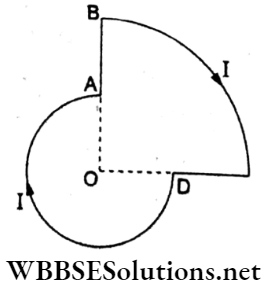
- \(\frac{5}{16}\), out of the plane of the paper
- \(\frac{5}{16}\), into the plane of the paper
- \(\frac{7}{16}\), out of the plane of the paper
- \(\frac{7}{16}\), into the plane of the paper
Answer: 4. \(\frac{7}{16}\) into the plane of the paper
The magnetic field at the center O due to both the segments will be directed into the plane of the paper and hence will add up. Magnetic field due to the arc of radius R is
⇒ \(B_1=\frac{3}{4} \frac{\mu_0 I}{2 R}\)
and due to the arc of radius 2R is
⇒ \(B_2=\frac{1}{4} \frac{\mu_0 I}{2(2 R)}=\frac{\mu_0 I}{16 R}\)
∴ \(B_{\text {net }}=B_1+B_2=\frac{7}{16}\left(\frac{\mu_0 I}{R}\right)\)
Question 11. A wire carrying a steady current I has the shape shown in the adjoining figure. The linear parts of the wire are very long and parallel to the x-axis while the semicircular portion, of radius R, lies in the yz-plane. The magnetic field at O is
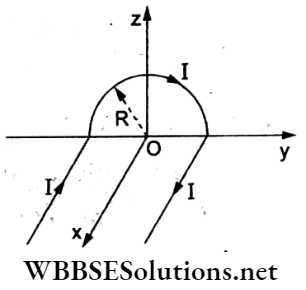
- \(\vec{B}=\frac{\mu_0}{4 \pi} \frac{I}{R}(\pi \hat{i}+2 \hat{k})\)
- \(\vec{B}=-\frac{\mu_0}{4 \pi} \frac{I}{R}(\pi \hat{i}-2 \hat{k})\)
- \(\vec{B}=-\frac{\mu_0}{4 \pi} \frac{I}{R}(\pi \hat{i}+2 \hat{k})\)
- \(\vec{B}=\frac{\mu_0}{4 \pi} \frac{I}{R}(\pi \hat{i}-2 \hat{k})\)
Answer: 3. \(\vec{B}=-\frac{\mu_0}{4 \pi} \frac{I}{R}(\pi \hat{i}+2 \hat{k})\)
The magnetic field at the center O of the semicircle
- Due to the semicircular currents \(\vec{B}_1=\frac{\mu_0 I}{4 R}(-\hat{i})\) and
- Due to the straight currents is \(\overrightarrow{B_2}=2\left(\frac{\mu_0}{4 \pi R} I\right)(-\hat{k})\).
Hence, the net field at O is
∴ \(\vec{B}=\overrightarrow{B_1}+\overrightarrow{B_2}=-\frac{\mu_0}{4 \pi} \frac{I}{R}(\pi \hat{i}+2 \hat{k}) .\)
Question 12. An electron moving in a circular orbit of radius r makes n revolutions per second. The magnetic field produced at the center has a magnitude of
- \(\frac{\mu_0 n e}{2 \pi r}\)
- \(\frac{\mu_0 n^2 e}{r}\)
- \(\frac{\mu_0 n e}{2 r}\)
- Zero
Answer: 3. \(\frac{\mu_0 n e}{2 r}\)
The motion of an electron revolving in a circular path is equivalent to an electric current \(I=\frac{e}{T}\) = ne.
The magnetic field at the center is
∴ \(B=\frac{\mu_0 I}{2 r}=\frac{\mu_0 n e}{2 r}\).
Question 13. An electron with a kinetic energy of 10 eV is undergoing a uniform circular motion in a plane perpendicular to a uniform magnetic field of 10-4 T. The orbital radius of the electron is
- 11 cm
- 18 cm
- 16 cm
- 12 cm
Answer: 1. 11 cm
The magnetic force \((\vec{F}=q \vec{v} \times \vec{B})\) provides the required centripetal force \(\left(=\frac{m v^2}{r}\right)\).
Hence, for θ = 90°, \(\frac{m v^2}{r}=q v B\)
⇒ mv = qBr => m2v2 = q2B2r2 →(1)
KE of the electron is
⇒ \(E=\frac{1}{2} m v^2=10 \mathrm{eV}\).
⇒ mv2 = 2E. →(2)
Dividing (1) by (2),
⇒ \(\frac{m^2 v^2}{m v^2}=\frac{q^2 B^2 r^2}{2 E}\)
⇒ radius of the orbit = t = \(\frac{\sqrt{2 m E}}{q B}\).
Substituting the values,
⇒ \(r=\frac{\sqrt{2\left(9.1 \times 10^{-31} \mathrm{~kg}\right)\left(10 \times 1.6 \times 10^{-19} \mathrm{~J}\right)}}{\left(1.6 \times 10^{-19} \mathrm{C}\right)\left(10^{-4} \mathrm{~T}\right)}\)
∴ 1.06 X 10 cm ≈11 cm.
Question 14. A deuteron of kinetic energy 50 keV is describing a circular orbit of radius 0.5 min a plane perpendicular to a magnetic field B. The kinetic energy of the proton that describes a circular orbit of radius 0.5 m in the same plane with the same magnetic field is
- 25keV
- 100 keV
- 50keV
- 200 keV
Answer: 2. 100 keV
The force experienced by a charged particle during circular motion in a magnetic field is given by
⇒ \(q v B=\frac{m v^2}{r}\)
⇒ Momentum = p = mv = qBr and KE = \(\frac{p^2}{2 m}=\frac{q^2 B^2 r^2}{2 m}\).
For a deuteron, KE = 50 keV, and q, B, and r are the same for both the deuteron and the proton.
⇒ Now, \(\mathrm{KE} \propto \frac{1}{m}\)
⇒ Hence, \(\frac{50 \mathrm{keV}}{E}=\frac{m_P}{m_D}=\frac{1}{2}\)
∴ KE of proton = E = 100 keV.
Question 15. The cyclotron frequency of an electron gyrating in a magnetic field of 1 T is approximately
- 280 MHz
- 28 GHz
- 280 GHz
- 2.8 GHz
Answer: 2. 28 GHz
Cyclotron frequency = \(f=\frac{q B}{2 \pi m}\).
Substituting the values,
⇒ \(f=\frac{\left(1.6 \times 10^{-19} \mathrm{C}\right)(1.0 \mathrm{~T})}{2(3.14)\left(9.1 \times 10^{-31} \mathrm{~kg}\right)}=28 \times 10^9 \mathrm{~Hz}=28 \mathrm{GHz}\).
“magnetic effects of electric current class 10 question answer “
Question 16. A conductor AB carrying a steady current I1 is placed near another long wire CD carrying a steady current I2, If the wire AB is free to move, it will have
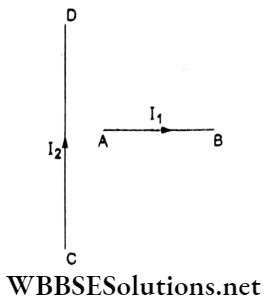
- Only rotational motion
- Only translational motion
- Rotational as well as translational motion
- Neither rotational nor translational motion
Answer: 3. Rotational as well as translational motion
The magnetic field to the right of the CD is directed perpendicularly inward into the plane of die paper in which the wire AB is placed. The forces f1,f2,…, will depend upon distance from CD and they decrease with an increase in d.
Hence, there will be a net force parallel to CD producing translational motion and a torque about B which will produce a rotational motion. Hence, there will be rotational as well as translational motion.
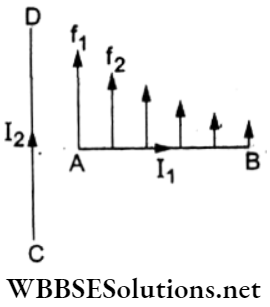
Question 17. Two conducting wires carrying
- Parallel currents repel each other
- Antiparallel currents attract each other
- Antiparallel currents repel each other
- Antiparallel currents of equal magnitudes attract each other
Answer: 3. Antiparallel currents repel each other
When two wires carry parallel currents, the force on each wire is due to the magnetic field produced by the other. Like (or parallel) currents always attract and unlike (or antiparallel) currents always repel.
Question 18. An uncharged particle is moving with a velocity of \(\vec{V}\) through a nonuniform magnetic field as shown. The velocity v would be
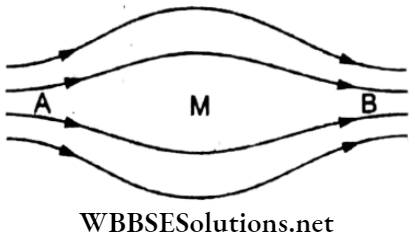
- Maximum at A and B
- Minimum at A and B
- Minimum at M
- The same at all points
Answer: 4. The same at all points
An uncharged particle does not interact with a magnetic field, so its velocity will be the same at all points (in terms of both magnitude and direction).
If the particle is charged and moves parallel to the magnetic field, the force \(|\vec{F}|=q v B \sin 0^{\circ}=0\), so the velocity is the same at all points.
Question 19. A coil in the shape of an equilateral triangle of side l is suspended between the poles of a permanent magnet such that \(\vec{B}\) is in the plane of the coil. If due to a current I in the triangle, a torque x acts on the coil, the side of the triangle is
- \(\frac{2}{\sqrt{3}}\left(\frac{\tau}{B I}\right)^{1 / 2}\)
- \(\frac{2}{\sqrt{3}}\left(\frac{\tau}{B I}\right)\)
- \(2\left(\frac{\tau}{\sqrt{3} B I}\right)^{1 / 2}\)
- \(\frac{1}{\sqrt{3}} \frac{\tau}{B}\)
Answer: 3. \(2\left(\frac{\tau}{\sqrt{3} B I}\right)^{1 / 2}\)
The magnetic moment of the current loop is
⇒ \(\vec{m}=I \vec{A}, \text { where } A=\frac{1}{2} \times l \times \frac{\sqrt{3}}{2} l=\frac{\sqrt{3} l^2}{4}\).
The magnitude of the torque in magnetic field B will be x = mB sin θ.
∴ Intially, \(\theta=90^{\circ} \cdot \tau=A I B=\frac{\sqrt{3}}{4} l^2 I B \Rightarrow l=\left(\frac{4 \tau}{\sqrt{3} I B}\right)^{1 / 2}=2\left(\frac{\tau}{\sqrt{3} I B}\right)^{1 / 2}\).
Question 20. A charged particle (charge q) is revolving in a circle of radius R with a uniform speed ν. The associated magnetic moment μ, is given by
- \(\frac{q v R}{2}\)
- \(\frac{q v R^2}{2}\)
- qvR
- qvR2
Answer: 1. \(\frac{q v R}{2}\)
Equivalent current, \(I=\frac{q}{T}=\frac{q v}{2 \pi R}\)
Associated magnetic moment
∴ \(m=I A=\frac{q v}{2 \pi R} \cdot \pi R^2=\frac{q v R}{2}\).
Question 21. A rectangular loop carrying a steady current I1 is situated coplanar near a long straight wire carrying a steady current I2. The wire is parallel to one of the sides of the loop as shown in the figure. Then, the current loop will
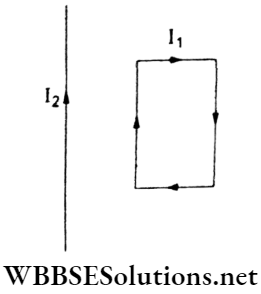
- Move away from the wire
- Move towards the wire
- Rotate about an axis parallel to the wire
- Remain stationary
Answer: 2. Move toward the wire
The coil PQRS is situated coplanar with the straight current-carrying wire. Force f1 on PQ is attractive and force f2 on RS is repulsive. Forces f3 and f4 are equal and opposite. Since f1 > f2, the current loop will move towards the wire.
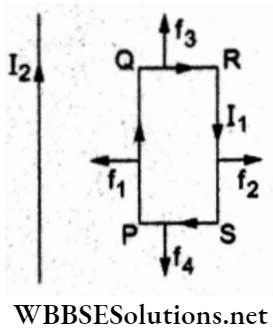
Question 22. A charged particle enters a magnetic field \(\vec{B}\) with initial velocity \(\vec{v}\), making an angle of 45° with \(\vec{B}\). The path of the particle will be
- An ellipse
- A circle
- A straight line
- A helix
Answer: 4. A helix
The velocity \(\vec{V}\) of the charged particle has two components: one component is parallel to the field = \(v_1=v \cos \theta\) and the other component is perpendicular to file field = \(v_{\perp}=v \sin \theta\).
The v⊥ component provides the centripetal force for circular motion and the v∥ component moves the particle ahead along the field. Because of this combined motion, the path followed by the charged particle will be a helix.
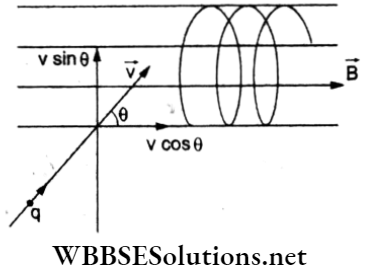
Question 23. The earth’s magnetic field at a given point is 0.5 x 10-5 Wb m-2. This field is to be annulled by the magnetic field at the center of a circular conducting loop of radius 5.0 cm. The current required to be flown in the loop is nearly
- 0.2 A
- 4 A
- 40 A
- 0.4 A
Answer: 4. 0.4 A
The magnetic field at the center of a current-carrying circular coil is \(B=\frac{\mu_0 I}{2 R}\).
This must balance the earth’s field% = 0.5 x 10-5 T.
⇒ \(I=\frac{2 B_{\mathrm{H}} R}{\mu_0}=\frac{2\left(0.5 \times 10^{-5} \mathrm{~T}\right)\left(5.0 \times 10^{-2} \mathrm{~m}\right)}{4(3.14)\left(10^{-7} \mathrm{H} \mathrm{m}^{-1}\right)}\)
∴ 0.398 A = 0.4 A.
Question 24. A particle of mass m, charge q, and kinetic energy E enters a transverse uniform magnetic field B. After 3 s, the kinetic energy of the particle will be
- 2E
- 3E
- E
- 4E
Answer: 3. E
The magnetic force \(\vec{F}\) on a moving charged particle in a magnetic field is given by \(\vec{F}=q(\vec{v} \times \vec{B})\). Since \(\vec{F}\) is perpendicular to velocity \([\vec{V}/latex], the work done is zero, so the change in KE is zero. Hence, KE will remain unchanged as E.
Question 25. A particle of charge q and mass m enters a magnetic field [latex]\vec{B}\), perpendicularly. If the kinetic energy of the particle is E, five frequencies of revolution in its circular path will be
- \(\frac{q B}{\pi m}\)
- \(\frac{q B}{2 \pi m}\)
- \(\frac{q B E}{2 \pi m}\)
- \(\frac{q B}{2 \pi E}\)
Answer: 2. \(\frac{q B}{2 \pi m}\)
The magnetic forceF= qvB provides the required centripetal force \(\frac{m v^2}{r}\).
Hence, \(\frac{m v^2}{r}=q v B \Rightarrow \frac{m}{r} \frac{2 \pi r}{T}=q B\)
∴ frequency of revolution = f = \(\frac{1}{T}=\frac{q B}{2 \pi m}\).
Question 26. A uniform magnetic field acts at right angles to the direction of the motion of electrons. As a result, the electrons move in a circular path of radius 2 cm. If the speed of the electrons is doubled, the radius of the circular path will become
- 2 cm
- 4 cm
- 1cm
- 0.5 cm
Answer: 2. 4 cm
Since \(\frac{m v^2}{R}=q v B\), the radius of the circular path is R = \(\frac{m v}{q B}=\left(\frac{m}{q B}\right) v=k v\)
When the speed doubled, R’ = k (2v)
⇒ \(\frac{R^{\prime}}{R}=\frac{k(2 v)}{k v}=2 \Rightarrow R^{\prime}=2 R=2(2 \mathrm{~cm})=4 \mathrm{~cm}\).
Question 27. A charged particle moving with a velocity \(\vec{v}=v \hat{i}\) is subjected to a uniform magnetic field \(\vec{B}=-B \hat{i}\). As a result, the particle will
- Move along a helical path around the X-axis
- Startmovingin a circular yz-plane
- Retard along the x-axis
- Remain unaffected
Answer: 4. Remain unaffected
Given, \(\vec{v}=v \hat{i} \text { and } \vec{B}=-B \hat{i}\).
⇒ \(\vec{F}=q(\vec{v} \times \vec{B})=q v B(\hat{i}) \times(-\hat{i})=0\)
Since the force is zero, the particle’s motion will remain unaffected.
Question 28. A positively charged particle moving due east enters a region of uniform magnetic field directed vertically upwards. The particle will
- Continue to move due east
- Get deflected vertically upwards
- Move in a circular orbit with increased speed
- Move in a circular path with its speed unchanged
Answer: 4. Move in a circular path with its speed unchanged
Given, \(\vec{v}=v \hat{i} \text { and } \vec{B}=B \hat{k}\).
The magnetic force on the charged particle inside the magnetic field,
⇒ \(\vec{F}=q \vec{v} \times \vec{B}=q v B(\hat{i} \times \hat{k})=-q v B \hat{j}\).
The particle moves towards the right, following a circular path with speed unchanged.
“magnetic effects of electric current class 10 question answer “
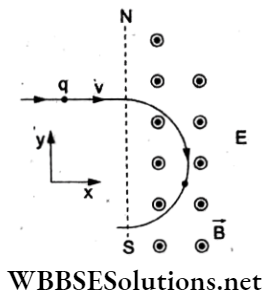
Question 29. Two charges +q and -q are attached to the two ends of a light rod of length L as shown in the figure. The system is given a velocity \(\vec {V}\) perpendicular to the magnetic field \(\vec{B}\). The magnetic force on the system of charges and the magnitude of the force on one charge of the system are respectively
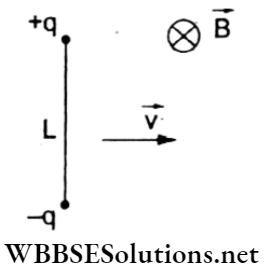
- 0,0
- 2qvB, 0
- 0, qvB
- 2qvB, qvB
Answer: 3. 0, qvB
Since \(\vec{F}=q \vec{v} \times \vec{B}=q(v \hat{i}) \times(-B \hat{k})\)
⇒ \(q v B(-\hat{i} \times \hat{k})=q v B \hat{j}\).
Forces acting on the two charged particles will be equal and opposite along the y-axis, so the net force on the system is zero while the magnitude of the force on one single particle will be qvB.
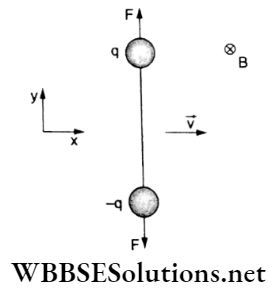
Question 30. In the trajectory of the particles in a uniform magnetic field, which particle has the highest e/m value?
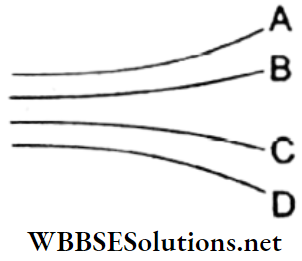
- A
- B
- C
- D
Answer: 4. D
For the curved path followed by a moving charge a magnetic field,
⇒ \(q v B=\frac{m v^2}{R} \Rightarrow \frac{q}{m}=\frac{v}{B R}=\frac{k}{R}\)
⇒ \(\text { ratio } \frac{q}{m} \propto \frac{1}{R}\).
For the smallest radius of curvature R, the ratio \(\) is maximum, which is true for D.
| Class 11 Physics | Class 12 Maths | Class 11 Chemistry |
| NEET Foundation | Class 12 Physics | NEET Physics |
Question 31. An electron is traveling along the x-direction. It encounters a magnetic field in the y-direction. Its subsequent motion will be a
- Straight line along the x-direction
- Circle in the xz-plane
- Circle in the yz-plane
- Circle in the xy-plane
Answer: 2. Circlein the xz-plane
Given that \(\vec{v}=v \hat{i} \text { and } \vec{B}=B \hat{j}\). Hence, \(\vec{F}=q(\vec{v} \times \vec{B})=q v B(\hat{i} \times \hat{j})=q v B \hat{k}\).
The centripetal force is along the z-direction. Hence, the path followed will be a circle in the xz-plane.
Note: The axis of the circular path followed will be the direction of the magnetic field, which is along the y-axis, so the plane of motion will be the xz-plane.
Question 32. A current-carrying coil is subjected to a uniform magnetic field. The coil will orient itself such that its plane becomes
- Inclined at 45 to the magnetic field
- Inclined at any arbitrary angle to the magnetic field
- Parallel to the magnetic field
- Perpendicular to the magnetic field
Answer: 4. Perpendicular to the magnetic field
A current-carrying coil is equivalent to a magnetic dipole whose magnetic moment is \(\vec{m}=I \vec{A}\).
In a magnetic field, it has PE = U = \(-\vec{m} \cdot \vec{B}=-I(\vec{A} \cdot \vec{B})=-I A B \cos \theta\),
where θ= the angle between the normal to the area and the magnetic field. For the system to be stable, PE = minimum, so θ= 0.
Hence, the plane of the coil must be perpendicular to the field.
Question 33. The magnetic field due to a current of 0.1 A flowing through a circular coil of radius 0.1 m and 1000 turns at the center is
- 0.2 T
- 2 x 10-4
- 6.28 x 10-4 T
- 98 x 10-4 T
Answer: 3. 6.28 x 10-4 T
\(B=\frac{\mu_0 N I}{2 R}\)Given that/= 0.1 A,R= 0.1 m,N = 103
∴ \(B=\frac{\left(2 \pi \times 10^{-7}\right)\left(10^3\right)(0.1) \mathrm{T}}{0.1}=2(3.14)\left(10^{-4}\right) \mathrm{T}=6.28 \times 10^{-4} \mathrm{~T}\).
Question 34. If a charged particle enters a region where \(\vec{E}\) and \(\vec{B}\) fields are mutually perpendicular then will
- Always move in the direction of \(\vec{B}\)
- Always move in the direction of \(\vec{E}\)
- Always undergo circular motion
- May emerge undeflected from the fields
Answer: 4. May emerge undeflected from the fields
The Lorentz force is given by
⇒ \(\vec{F}=\vec{F}_{\text {elec }}+\vec{F}_{\text {mag }}=q \vec{E}+q \vec{v} \times \vec{B}\)
When the charged particle enters the region of crossed fields, it experiences electric and magnetic forces in opposite directions and may emerge undeflected when \(q E=q v B \Rightarrow v=\frac{E}{B}\).
Question 35. The magnetic field \(\overrightarrow{d B}\) due to a small element \(\overrightarrow{d l}\) at a distance \(\vec{r}\) carrying a steady current I will be
- \(\overrightarrow{d B}=\frac{\mu_0}{4 \pi} I\left(\frac{\overrightarrow{d l} \times \vec{r}}{r}\right)\)
- \(\overrightarrow{d B}=\frac{\mu_0}{4 \pi} I^2\left(\frac{\overrightarrow{d l} \times \vec{r}}{r^2}\right)\)
- \(\overrightarrow{d B}=\frac{\mu_0}{4 \pi} I^2\left(\frac{\overrightarrow{d l} \times \vec{r}}{r}\right)\)
- \(\overrightarrow{d B}=\frac{\mu_0}{4 \pi} I\left(\frac{\overrightarrow{d l} \times \vec{r}}{r^3}\right)\)
Answer: 4. \(\overrightarrow{d B}=\frac{\mu_0}{4 \pi} I\left(\frac{\overrightarrow{d l} \times \vec{r}}{r^3}\right)\)
According to the Biot-Savartlaw, the magnetic field at point O will be \(d B=\frac{\mu_0}{4 \pi} \frac{I d l \sin \theta}{r^2}\) which will be directed perpendicularly into the plane of the paper. In vector notation,
⇒ \(\overrightarrow{d B}=\frac{\mu_0}{4 \pi} \frac{I \overrightarrow{d l} \times \hat{r}}{r^2}=\frac{\mu_0}{4 \pi} I\left(\frac{\overrightarrow{d l} \times \vec{r}}{r^3}\right)\)
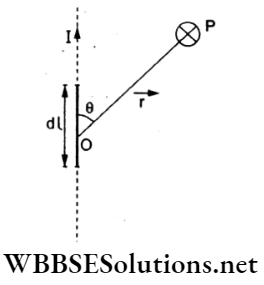
Question 36. Abeam of monoenergetic electrons is moving at a constant velocity through a region having mutually perpendicular electric and magnetic fields of intensities 20 V mf1 and 0.5 T respectively at right angles to the direction of motion of the electrons. The velocity of the electrons must be
- 8ms-1
- 40 ms-1
- 20 ms-1
- 10 ms-1
Answer: 3. 20 ms-1
For the beam of electrons to emerge undeflected through the crossed \(\vec{E}\) and \(\vec{B}\) fields, the electric and magnetic forces must balance each other.
Hence, qE = qvB
∴ \(v=\frac{E}{B}=\frac{20 \mathrm{Vm}^{-1}}{0.5 \mathrm{~T}}=40 \mathrm{~m} \mathrm{~s}^{-1}\).
Question 37. Two electric currents are .flowing perpendicular to each other as shown in the figure. AB and CD are perpendicular lines symmetrically placed relative to the currents. Where should we expect the resultant magnetic field to be zero?
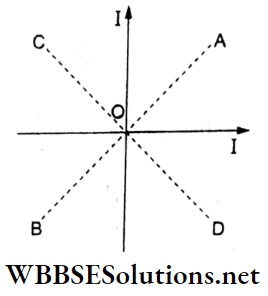
- On AB
- On CD
- On both AB and CD
- On both OD and BO
Answer: 1. On AB
The directions of the magnetic fields due to straight currents are shown close to the wires by Θ indicating a direction out of the paper and ⊗ indicating a direction the paper.
In the 1st and 3rd quadrants, the directions of the fields are in opposite directions so they cancel out, while in the 2nd and 4th quadrants, they are in the same direction.
Hence, the magnetic field will be zero on the line AB
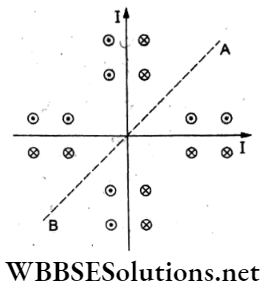
Question 38. Two straight wires are held perpendicular to the plane of the paper and are 5 m apart. They carry steady currents of 2.5 A and 5.0 A in the same direction. The magnitude of the magnetic field at a point midway between the wires will be
- \(\frac{\mu_0}{4 \pi} T\)
- \(\frac{\mu_0}{2 \pi} T\)
- \(\frac{3 \mu_0}{2 \pi} T\)
- \(\frac{3 \mu_0}{4 \pi} T\)
Answer: 2. \(\frac{\mu_0}{2 \pi} T\)
The magnetic field midway between two parallel, straight currents is in opposite directions. Hence, B = B1 – B2.
⇒ Here, \(B_1=\frac{\mu_0 I_1}{2 \pi d} \text { and } B_2=\frac{\mu_0 I_2}{2 \pi d}\)
∴ \(B=\frac{\mu_0}{2 \pi d}\left(I_2-I_1\right)=\frac{\mu_0}{2 \pi(5 \mathrm{~m}) / 2}(5.0-2.5) \mathrm{A}=\frac{\mu_0}{2 \pi} \mathrm{T}\)
“magnetic effects of electric current class 10 question answer “
Question 39. The magnetic field at the center of a circular coil of a single turn is B. If the same wire is coiled into two turns, the magnetic field at the center for file same current will be
- \(\frac{B}{4}\)
- \(\frac{B}{2}\)
- 2B
- 4B
Answer: 4. 4B
When the coil has a single turn, \(B=\frac{\mu_0 I}{2 R}\).
When it has two turns,
⇒ \(2\left(2 \pi R^{\prime}\right)=2 \pi R \Rightarrow R^{\prime}=\frac{R}{2}\)
∴ Now \(B^{\prime}=\frac{\mu_0 N I}{2 R^{\prime}}=\frac{\mu_0 2 I}{2 R / 2}=\frac{4 \mu_0 I}{2 R}=4 B\).
Question 40. A charged particle moves through a magnetic field in a direction perpendicular to it. Then, the
- Acceleration remains unchanged
- Velocity remains unchanged
- The speed of the particle remains unchanged
- The direction of the particle’s motion remains unchanged
Answer: 3. The Speed of the particle remains unchanged
For a charged particle moving through the magnetic field, the work done is zero, so the speed of the particle remains unchanged.
Question 41. An electron revolves in a circular orbit with a uniform speed v. It produces a magnetic field B at the center. The radius of the circle is proportional to
- \(\frac{B}{v}\)
- \(\frac{v}{B}\)
- \(\sqrt{\frac{v}{B}}\)
- \(\sqrt{\frac{B}{v}}\)
Answer: 3. \(\sqrt{\frac{v}{B}}\)
Speed = \(v=\frac{2 \pi R}{T}\)
⇒ equivalent current = \(I=\frac{e}{T}=\frac{e v}{2 \pi R}\)
The magnetic field at the center is
⇒ \(B=\frac{\mu_0 I}{2 R}=\frac{\mu_0}{2 R}\left(\frac{e v}{2 \pi R}\right)\)
⇒ \(R^2=\frac{\mu_0 e v}{4 \pi B}=\left(\frac{\mu_0 e}{4 \pi}\right) \frac{v}{B}\)
∴ \(R^2 \propto \frac{v}{B} \Rightarrow R \propto \sqrt{\frac{v}{B}}\).
Question 42. A conducting circular loop of radius R is connected to a long, straight wire which carries a steady current I as shown. The magnetic field at the center O of the loop is
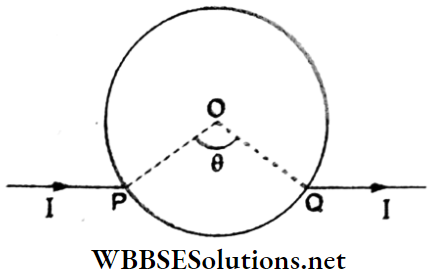
- Directed into the plane of the loop
- Directed out of the plane of the loop
- Dependent on the angle of 0
- Zero for all values of 0
Answer: 4. Zero for all values of 0
If B1 and B2 are the magnetic fields at the center O due to the upper branch and lower branch of the loop then
⇒ \(\frac{B_1}{B_2}=\frac{I_1 h_1}{I_2 l_2}, \text { since } B=\frac{\mu_0 I l}{4 \pi d^2}=k(I l)\)
⇒ But, \(\frac{I_1}{I_2}=\frac{R_2}{R_1}=\frac{\sigma l_2}{\sigma l_1}=\frac{l_2}{l_1}\) where a = resistance per unit length
∴ \(\frac{B_1}{B_2}=\left(\frac{l_2}{l_1}\right)\left(\frac{l_1}{l_2}\right)=1 \Rightarrow B_1=B_2\)
Since B1 and B2 are in opposite directions, Bnet at O= 0 for all values of 0.
Question 43. A beam of electrons emerges undeflected through mutually perpendicular electric and magnetic fields. If the electric field is switched off and the same magnetic field is maintained, the electrons move
- In an elliptical orbit
- In a circular orbit
- Along a parabolic path
- Along a straight line
Answer: 2. In a circular orbit
In a magnetic field, the path followed by a charge moving perpendicular to the field will be circular.
Question 44. The magnetic force acting on a particle with charge (-2 μC) in a magnetic field of 2T directed along the y-direction, when the particle velocity is \(\vec{v}=(2 \hat{i}+3 \hat{j}) \times 10^6 \mathrm{~m} \mathrm{~s}^{-1}\), is
- 8N in the +z direction
- 4N in the +z direction
- 8N in the -y direction
- 8N in the -z-direction
Answer: 4. 8N in the -z-direction
Given that q = \(\left(-2 \times 10^{-6} C\right), \vec{B}=(2 T) \hat{j}\)
⇒ and velocity = \(\vec{v}=(2 \hat{i}+3 \hat{j}) \times 10^6 \mathrm{~m} \mathrm{~s}^{-1}\)
⇒ Magnetic force = \(\vec{F}=q(\vec{v} \times \vec{B})\)
⇒ \(\left(-2 \times 10^{-6} \mathrm{C}\right)(2 \hat{i}+3 \hat{j})\left(10^6 \mathrm{~m} \mathrm{~s}^{-1}\right) \times(2 \hat{j} T)\)
∴ \(-4(2 \hat{k}) N=-8 \hat{k} N=8 N\) along the z-direction.
Question 45. A square current-carrying loop is suspended in a uniform magnetic field acting in the plane of the loop. If the force on one arm of the loop is \(\vec{F}\), the net force on the remaining three arms is
- \(3 \vec{F}\)
- \(2 \vec{F}\)
- \(-\vec{F}\)
- \(-3 \vec{F}\)
Answer: 3. \(-\vec{F}\)
The current-carrying square loop, when placed in a uniform magnetic field such that the direction of B is parallel to the plane of the coil, then the force acting on arm PQ is directed perpendicularly into the plane of the paper, while that on RS will be perpendicularly out of the plane of the paper. Both have equal magnitude, i.e., \(\left|\vec{F}_1\right|=\left|\vec{F}_2\right|=I B l\) but are in opposite directions.
Thus, \(\vec{F}_2=-\vec{F}\)
Since currents through QR and PS are along the line of a magnetic field \(\vec{B}\), they do not experience any magnetic force.
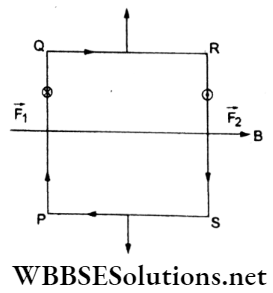
Question 46. A beam of cathode rays is subjected to crossed electric \(\vec{E}\) and magnetic \(\vec{B}\) fields. The electric field is adjusted by regulating the potential difference V between the electrodes such that the beam emerges undeflected. The specific charge of the cathode rays is given by
- \(\frac{B^2}{2 V E^2}\)
- \(\frac{2 V B^2}{E^2}\)
- \(\frac{2 V E^2}{B^2}\)
- \(\frac{E^2}{2 V B^2}\)
Answer: 4. \(\frac{E^2}{2 V B^2}\)
The kinetic energy gained by the accelerating voltage V is
⇒ \(\frac{1}{2} m v^2=q V\)
Specific charge = \(\frac{q}{m}=\frac{v^2}{2 V}\)
For cathode rays to emerge undeflected,
∴ \(v=\frac{E}{B} \text {, hence } \frac{q}{m}=\frac{1}{2 V}\left(\frac{E}{B}\right)^2=\frac{E^2}{2 V B^2}\).
Question 47. A square conducting loop ABCD, carrying a steady current I2, is placed near and coplanar with a long straight conductor XY, carrying a steady current I1 as shown in the figure. The net force on the loop will be
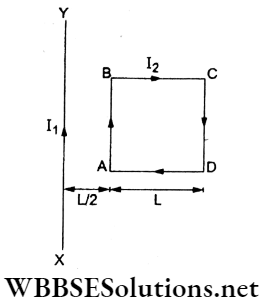
- \(\frac{2 \mu_0 I_1 I_2}{2 \pi}\)
- \(\frac{\mu_0 I_1 I_2 L}{2 \pi}\)
- \(\frac{2}{3} \frac{\mu_0 I_1 I_2 L}{\pi}\)
- \(\frac{2 \mu_0 I_1 I_2}{3 \pi}\)
Answer: 4. \(\frac{2 \mu_0 I_1 I_2}{3 \pi}\)
Forces on sides BC and AD are equal and opposite.
The attractive force on side AB is
⇒ \(F_1=\frac{\mu_0 I_1 I_2 L}{2 \pi L / 2}=\frac{\mu_0 I_1 I_2}{\pi}\)
Repulsive force on the side CD is
⇒ \(F_2=\frac{\mu_0 I_1 I_2 L}{2 \pi(3 L / 2)}=\frac{\mu_0 I_1 I_2}{3 \pi}\)
∴ \(F_{\text {net }}=\left(F_1-F_2\right)=\frac{\mu_0 I_1 I_2}{\pi}-\frac{\mu_0 I_1 I_2}{3 \pi}=\frac{2 \mu_0 I_1 I_2}{3 \pi}\)
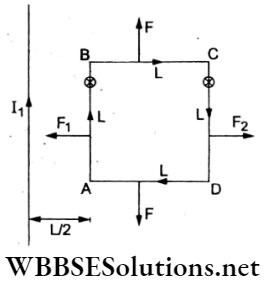
Question 48. The magnetic field at the center O of the arc, as shown in the figure, is
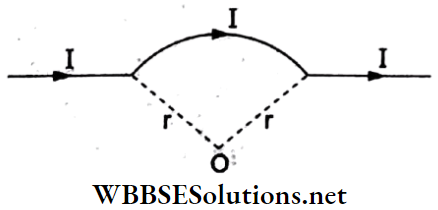
- \(\frac{2 I}{r}(\pi+\sqrt{2}) \times 10^{-7} \mathrm{~T}\)
- \(\frac{2 I}{r}\left(\frac{\pi}{4}+\sqrt{2}\right) \times 10^{-7} \mathrm{~T}\)
- \(\frac{I}{r}(\pi+\sqrt{2}) \times 10^{-7} \mathrm{~T}\)
- \(\frac{I}{r}\left(\frac{\pi}{4}+\sqrt{2}\right) \times 10^{-7} \mathrm{~T}\)
Answer: 2. \(\frac{2 I}{r}\left(\frac{\pi}{4}+\sqrt{2}\right) \times 10^{-7} \mathrm{~T}\)
The distance of each straightpart from thecentreOisd =rcos 45° = \(\frac{r}{\sqrt{2}}\).
The field due to each segment is directed perpendicularly into the plane of the paper, so the fields add up.
\(B_1=\frac{\mu_0 I}{4 \pi d}=\frac{\mu_0 I}{4 \pi r / \sqrt{2}}=\frac{\sqrt{2} \mu_0 I}{4 \pi r}\)⇒ \(B_2=\frac{\mu_0 I}{4(2 r)}=\frac{\mu_0 I}{8 r}\)
∴ Bnet = B1 + B2 + B3 = 2B1+ B2 [∵ B3 = B1]
⇒ \(\frac{\sqrt{2} \mu_0 I}{2 \pi r}+\frac{\mu_0 I}{8 r}=\frac{I}{r} 2 \sqrt{2} \times 10^{-7}+\frac{I}{r} \frac{\pi}{2} \times 10^{-7}\)
⇒ \(\frac{I}{r}\left(2 \sqrt{2}+\frac{\pi}{2}\right) \times 10^{-7} \mathrm{~T}=\frac{2 I}{r}\left(\frac{\pi}{4}+\sqrt{2}\right) \times 10^{-7} \mathrm{~T}\)
“magnetic effects of electric current class 10 question answer “
Question 49. A particle of charge q and mass m starts moving from the origin under the action of an electric field \(\vec{E}=E_0 \hat{i}\) and a magnetic field \(\vec{B}=B_0 \hat{i}\) at a velocity \(\vec{v}=v_0 \hat{j}\). The speed of the particle will become \(\frac{\sqrt{5}}{2} v_0\) after a time
- \(\frac{m v_0}{q E_0}\)
- \(\frac{m v_0}{2 q E_0}\)
- \(\frac{\sqrt{3} m v_0}{2 q E_0}\)
- \(\frac{\sqrt{5} m v_0}{2 q E_0}\)
Answer: 2. \(\frac{m v_0}{2 q E_0}\)
Given that \(\vec{E}=E_0 \hat{i}, \vec{B}=B_0 \hat{i} \text { and } \vec{v}=v_0 \hat{j}\).
Since v is perpendicular to \(\vec{}B\), the path will be circular, while the electric field will push (accelerate) the particle along the x-direction with acceleration \(a_x=\frac{q E_0}{m}\).
⇒ At time t, \(v_x=0+a_x t=\frac{q E_0}{m} t\).
Due to the magnetic field, the speed always remains constant(= v0) and perpendicular to the x-axis.
the magnitude of the resultant velocity,
⇒ \(v=\sqrt{v_x^2+v_y^2}=\sqrt{v_0^2+\left(\frac{q E_0}{m} t\right)^2}\)
⇒ \(\left(\frac{\sqrt{5}}{2} v_0\right)^2=v_0^2+\frac{q^2 E_0^2}{m^2} t^2\)
∴ \(t=\frac{m v_0}{2 g E_0}\).
Question 50. A wire of mass 100 g and length 1 m carries a steady current of 5 A. It is balanced in mid-air by a uniform magnetic field B. The value of B is
- 0.1 TI
- 0.2 T
- 0:ST
- 0.6 T
Answer: 2. 0.2 T
For balance, the force due to the magnetic field FB = IIB, and the weight
W= mg must balance each other. Thus, IIB = mg
∴ \(B=\frac{m g}{I l}=\frac{\left(100 \times 10^{-3} \mathrm{~kg}\right)\left(10 \mathrm{~m} \mathrm{~s}^{-2}\right)}{(5 \mathrm{~A})(1 \mathrm{~m})}=0.2 \mathrm{~T}\).
Question 51. When a charged particle enters a uniform magnetic field with uniform velocity, its trajectory can be
- A straight line
- A circle
- A helix
- (1) only
- (1) or (2)
- (1) or (3)
- Any one of (1), (2) and (3)
Answer: 4. Any one of (1), (2) and (3)
When the direction of the charged particle is parallel or antiparallel to the \(\vec{B}\)-field, the force \((\vec{F}=q \vec{v} \times \vec{B})\) is zero and hence the path will be a straight line. When \(\vec{V}\) and \(\vec{B}\) are perpendicular to each other, the path will be circular. And when the angle between \(\vec{V}\)and \(\vec{B}\) is 0(≠ 90°), the path will be helical. Hence, all the three paths are possible.
Question 52. The magnetic field due to a straight current-carrying cylindrical conductor of uniform cross-section of radius R is represented by
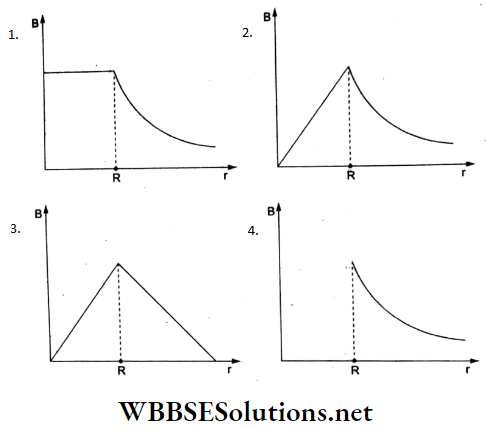
Answer: 2.
The magnetic fields inside a current-carrying cylindrical conductor of
radius R are as follows.
⇒ \(\text { For } 0<r<R, B=\frac{\mu_0 I}{2 \pi R^2} r \Rightarrow B \propto r\).
This represents a straight line through the origin.
⇒ \(\text { For } r>R, B=\frac{\mu_0 I}{2 \pi r} \Rightarrow B \propto \frac{1}{r}\).
This represents a nonlinear decrease (rectangular hyperbola) of B with r.
Hence, option (2)is correct.
Question 53. When a charged particle moving with a velocity \(\vec{V}\) is subjected to a magnetic field \(\vec{B}\), the force exerted on it is nonzero. This implies that the angle between
- \(\vec{B}\) and \(\vec{V}\) is necessarily
- \(\vec{V}\) and \(\vec{B}\) can have any value other than 90°
- \(\vec{V}\) and \(\vec{B}\) can have any value other than 0° and 180°
- \(\vec{V}\) and \(\vec{B}\) is either zero or 180°
Answer: 3. \(\vec{V}\) and \(\vec{B}\) can have any value other than 0° and 180°
The force on a charged particle in a magnetic field is
⇒ \(\vec{F}=q(\vec{v} \times \vec{B})\)
⇒ F- qvBsin 0, when0 is the angle between \(vec{V}\) and \(vec{B}\).
For θ= 0 or 180°, F= 0. So, for the force to be nonzero, θ can have any value other than 0° and 180°.
Question 54. A current loop in a magnetic field
- Experiences a torque whether the field is uniform or nonuniform in all orientations
- Can be equilibrium in one orientation
- Can be in equilibrium in two orientations and both the equilibrium states are unstable
- Can be equilibrium in two orientations, one is stable while the other is unstable
Answer: 4. Can be equilibrium in two orientations, one is stable while the other is unstable
A current loop is equivalent to a magnetic dipole with magnetic moment \(\), where the area vector \(\vec{A}\) is perpendicular to the plane of the coil.
In a magnetic field B, the potential energy
⇒ \(U=-\vec{m} \cdot \vec{B}=-m B \cos \theta\)
For θ = 0°, U = -mB = minimum, which corresponds to stable equilibrium.
For θ =180°, U = +mB = maximum, which corresponds to unstable equilibrium.
Question 55. An electron is moving in a circular path under the influence of a transverse magnetic field of 3.57 x 10-2 T. If the specific charge of the electron is 1.76 x 1011 C kg-1, the frequency of revolution of the electron is
- 100 MHz
- 1 GHz
- 62.8 MHz
- 6.28 MHz
Answer: 2. 1 GHz
Frequency of revolution is \(f=\frac{q B}{2 \pi m}=\left(\frac{q}{m}\right) \frac{B}{2 \pi}\)
Given, specific charge \(\left(\frac{q}{m}\right)\) of an electron = 1.76xlOn Ckg-1 and magnetic field = B= 3.57 x10-2 T.
⇒ frequency = \(f=\left(1.76 \times 10^{11} \mathrm{C} \mathrm{kg}^{-1}\right)\left(\frac{3.57 \times 10^{-2} \mathrm{~T}}{2 \times 3.14}\right)\)
∴ 1.0 x 109Hz=1 GHz
Question 56. A long cylindrical wire of radius b carries a steady current I distributed uniformly over its cross-section. The magnitude of the magnetic field at a point inside the wire at a distance from the axis is
- \(\frac{\mu_0 I a}{2 \pi b^2}\)
- \(\frac{\mu_0 I b}{2 \pi a^2}\)
- \(\frac{\mu_0 I a}{2 \pi b}\)
- \(\frac{\mu_0 I b}{2 \pi a}\)
Answer: 1. \(\frac{\mu_0 I a}{2 \pi b^2}\)
Consider the Amperian circular loop of radius a coaxial with the axis of the cylindrical wire. Currently enclosed in the loop is
⇒ \(I_0=\frac{I \cdot \pi a^2}{\pi b^2}=\frac{I a^2}{b^2}\)
Applying Ampere’s circuital law
⇒ \(\oint \vec{B} \cdot \overrightarrow{d l}=B \cdot 2 \pi a=\mu_0 I_0=\mu_0 \frac{I a^2}{b^2}\)
∴ \(B=\frac{\mu_0 I a}{2 \pi b^2}\)
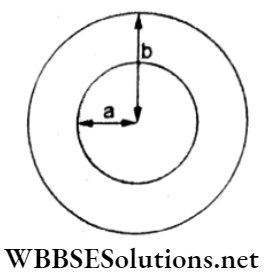
Question 57. A moving charge produces
- A magnetic field only
- An electric field only
- Both magnetic and electric fields
- Neither an electric nor a magnetic field
Answer: 3. Both magnetic and electric fields
A stationary charge produces an electric field only. While moving, it acts as a current element and thus produces a magnetic field in addition to an electric field.
Question 58. A charged particle is released from rest in a region that comprises the uniform electric field \(\vec{E}=E_0 \hat{i}\) and uniform magnetic field \(\vec{B}=B_0 \hat{i}\). The charged particle (neglect gravity)
- Will remain at rest
- Will move along the x-axis with a uniform velocity
- Will move along the x-axis with a uniform acceleration
- Will follow a parabolic path
Answer: 3. Will move along the x-axis with a uniform acceleration
A charged particle at rest will not experience a force in a magnetic field, but an electric field \(\vec{E}\) will exert a force \(\vec{F}_{\text {elec }}=q \vec{E}=q E_0 \hat{i}\) on it and the particle will start moving with a constant acceleration \(\vec{a}=\frac{\vec{F}}{m}=\frac{q E_0 \hat{i}}{m}\).
⇒ Since velocity \(\vec{V}\) and \(\vec{B}\) are both along the x-axis, magnetic force \(\vec{F}_B=q(\vec{v} \times \vec{B})=q v B \sin \theta=0\).
So, the motion will be along the x-axis with uniform acceleration.
Question 59. Ionized hydrogen atoms and a-particles with the same momenta enter perpendicular to a constant magnetic field B. The ratio of the radii of their paths rH: rα will be
- 2:1
- 1:2
- 4:1
- 1:4
Answer: 1. 2:1
For the motion of a charged particle in a constant magnetic field, the centripetal force is
⇒ \(\frac{m v^2}{r}=q v B \Rightarrow r=\frac{m v}{q B}=\frac{p}{q B}\)
⇒ For \(\mathrm{H}: r_{\mathrm{H}}=\frac{p}{e B} ; \text { for } \alpha \text {-particle }: r_\alpha=\frac{p}{(2 e) B}\)
∴ \(r_{\mathrm{H}}: r_\alpha=2: 1\).
Question 60. A cylindrical conductor of radius R is carrying a constant steady current. Which of the following correctly represents the plot of the magnitude of the magnetic field B with a distance d from the axis of the conductor?
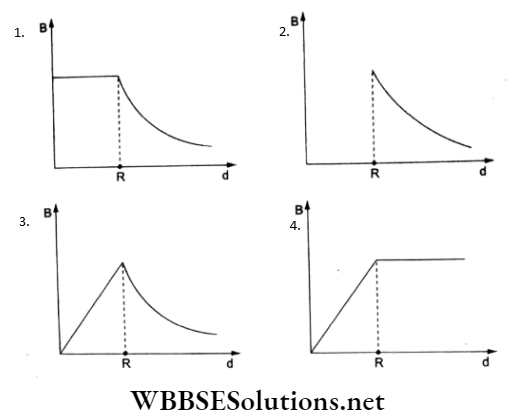
Answer: 3.
Current per unit base area of the cylindrical conductor = \(\frac{I}{\pi R^2}\)
According to Ampere’s circuital law,
⇒ \(\oint \vec{B} \cdot \overrightarrow{d l}=\mu_0 \Sigma I\)
Thus, ford \(d<R, B \cdot 2 \pi d=\frac{\mu_0 I \pi d^2}{\pi R^2}\)
⇒ \(B=\frac{\mu I}{2 \pi R^2} d \Rightarrow B \propto d\)
This represents a straight line from d =0tod= R
⇒ \(d>R, B \cdot 2 \pi d=\mu_0 I\)
∴ \(B=\left(\frac{\mu_0 I}{2 \pi}\right) \frac{1}{d}=k\left(\frac{1}{d}\right)\).
This represents a rectangular hyperbola, as in (3).
Question 61. If two protons are moving with speed v= 4.5 x 105 m s-1 parallel to each other then the ratio of the electrostatic and magnetic forces between them is
- 4.4 x 105
- 2.2 x 105
- 3.3 x 105
- l.l x 105
Answer: 1. 4.4 x 105
The electrostatic force between the two protons is \(F_{\text {elec }}=\frac{1}{4 \pi \varepsilon_0} \frac{q^2}{r^2}\)
Moving charge is equivalent to a current I, where Idl = qv.
⇒ Magnetic field = B = \(\frac{\mu_0}{4 \pi} \frac{I d l}{r^2}=\frac{\mu_0}{4 \pi} \frac{q v}{r^2}\)
⇒ Hence, magnetic force = \(F_{\text {mag }}=q v B=\frac{\mu_0}{4 \pi} \frac{q^2 v^2}{r^2}\)
∴ Ratio \(\frac{F_{\text {elec }}}{F_{\text {mag }}}=\frac{\frac{1}{4 \pi \varepsilon_0} \frac{q^2}{r^2}}{\frac{\mu_0}{4 \pi} \frac{q^2 v^2}{r^2}}=\frac{9 \times 10^9}{10^{-7}} \frac{1}{\left(4.5 \times 10^5\right)^2}=4.4 \times 10^5\).
Question 62. Find the magnetic field at the center O. Given that 1 = 2.5 A and r = 5 cm.
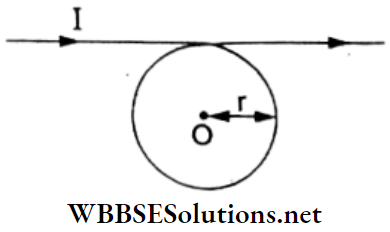
- \(\pi\left(1+\frac{1}{\pi}\right) \times 10^{-5} \mathrm{~T}\)
- \(\pi\left(1+\frac{1}{\pi}\right) \times 10^{-6} \mathrm{~T}\)
- \(\pi\left(\frac{\pi+1}{\pi}\right) \times 10^{-6} \mathrm{~T}\)
- \(\left(\frac{\pi+1}{\pi}\right) \times 10^{-6} \mathrm{~T}\)
Answer: 1. \(\pi\left(1+\frac{1}{\pi}\right) \times 10^{-5} \mathrm{~T}\)
The magnetic field at the center
Due to the straight current = \(\frac{\mu_0 I}{2 \pi r}\) (inward),
Due to the circular current = \(\frac{\mu_0 I}{2 r}\) (inward).
Hence, the net field B = \(\frac{\mu_0 I}{2 r}\left(1+\frac{1}{\pi}\right)=\frac{2 \pi \times 10^{-7} \times 2.5}{\left(5 \times 10^{-2}\right)}\left(1+\frac{1}{\pi}\right)\)
∴ \(\pi\left(1+\frac{1}{\pi}\right) \times 10^{-5} \mathrm{~T}\)
Question 63. Two infinitely long parallel current-carrying conducting wires are shown in the figure. If the magnetic field at A is zero, the value of I is
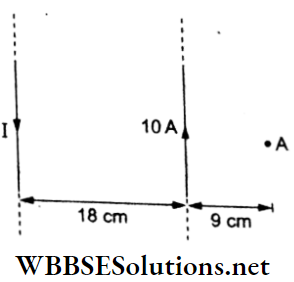
- 50 A
- 15 A
- 30 A
- 25 A
Answer: 3. 30 A
The magnetic field at A due to current I is
⇒ \(B_1=\frac{\mu_0 I}{2 \pi d}=\frac{\mu_0 I}{2 \pi(27 \mathrm{~cm})}\), direct outward.
Due to a current of 10 A, \(B_2=\frac{\mu_0(10 \mathrm{~A})}{2 \pi(9 \mathrm{~cm})}\), directed inward.
Given, = 0 => \(\frac{\mu_0 I}{2 \pi(27 \mathrm{~cm})}=\frac{\mu_0(10 \mathrm{~A})}{2 \pi(9 \mathrm{~cm})}\).
Hence, I = 30 A.
Question 64. Find the ratio of the strengths of E- and B-fields due to a point charge moving at a constant velocity of 4.5 x 105 m s-1.
- 2 x 1011
- 2 x l08
- 3 x 1011
- 3 x l08
Answer: 1. 2 x 1011
Electric field is E = \(\frac{1}{4 \pi \varepsilon_0} \frac{q}{r^2}\), and magnetic field is B = \(B=\frac{\mu_0}{4 \pi} \frac{q v}{r^2}\).
⇒ \(\frac{E}{B}=\frac{\left(9 \times 10^9\right) \frac{q}{r^2}}{\left(10^{-7}\right) \frac{q v}{r^2}}=\frac{9 \times 10^{16}}{v}=\frac{9 \times 10^{16}}{\frac{9}{2} \times 10^5}=2 \times 10^{11}\).
Question 65. Find the magnetic field inside a toroid along its axis if its average radius = 0.5 cm, current flowing through it = 1.5 A, number of turns = 250, and relative permeability = 700.
- 8.5 T
- 5.7 T
- 10.5 T
- 12.7 T
Answer: 3. 10.5 T
The magnetic field B inside a toroid is
B.2πR= uNI
⇒ \(B=\frac{\mu_r \mu_0 N I}{2 \pi R}=\frac{700\left(4 \pi \times 10^{-7}\right)(250)(1.5)}{2 \pi\left(0.5 \times 10^{-2}\right)}=10.5 \mathrm{~T}\).
Question 66. The current density in a solid cylindrical wire of radius R, as a function of radial distance r, is given by j = j0 \(\left(1-\frac{r}{R}\right)\) The total current in the radial region r = 0 to r = will be
- \(\frac{3}{64} \pi R^2 j_0\)
- \(\frac{1}{128} \pi R^2 j_0\)
- \(\frac{5}{32} \pi R^2 j_0\)
- \(\frac{5}{96} \pi R^2 j_0\)
Answer: 4. \(\frac{5}{96} \pi R^2 j_0\)
Current density is
⇒ \(j=\frac{d I}{d A}=\frac{d I}{2 \pi r d r}\)
⇒ \(d I=j \cdot 2 \pi r d r=j_0\left(1-\frac{r}{R}\right) 2 \pi r d r\)
Total current is
⇒ \(I=\int d I=j_0 \cdot 2 \pi \int_0^{R / 4}\left(1-\frac{r}{R}\right) r d r\)
⇒ \(2 \pi j_0\left[\frac{r^2}{2}-\frac{1}{R} \frac{r^3}{3}\right]_0^{R / 4}\)
∴ \(2 \pi j_0\left[\frac{R^2}{32}-\frac{R^2}{64 \times 3}\right]=\frac{5}{96} \pi R^2 j_0\).
Question 67. Consider a closed current-carrying semicircular loop That carries a steady current I as shown in the figure. Find the magnetic force per unit length on a small element at the center O.
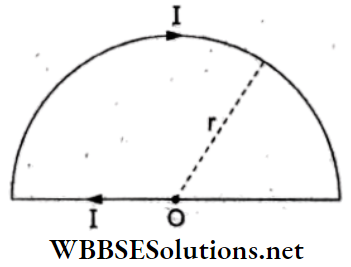
- \(\frac{\mu_0 I^2}{4 r}\)
- \(\frac{\mu_0 I^2}{2 r}\)
- \(\frac{2 \mu_0 I^2}{r}\)
- \(\frac{\mu_0 I^2}{r}\)
Answer: 1. \(\frac{\mu_0 I^2}{4 r}\)
The magnetic field at the center of the semicircular current loop is B = \(\frac{\mu_0 I}{4 r}[latex]
Magnetic force per unit length = [latex]\frac{I B \Delta l}{\Delta l}=I B=\frac{\mu_0 I^2}{4 r}\).
Question 68. An electron in a hydrogen atom revolves in the n = 3 states. Find the magnetic field at the center.
- 9T
- 0.1 T
- 0.5 T
- 0.05 T
Answer: 4. 0.05 T
The radius of the 3rd orbit in a hydrogen atom is r = n2a0 = 9a0, where a0 = Bohr radius = 5.3 x 10-11m.
Equivalent current = I = \(\frac{e}{T}=\frac{e v}{2 \pi r}\)
The magnetic field at the center is
⇒ \(B=\frac{\mu_0 I}{2 r}=\frac{\mu_0}{2 r} \cdot \frac{e v}{2 \pi r}=\frac{\mu_0}{4 \pi} \frac{e}{r^2} v\)
⇒ \(\frac{\mu_0}{4 \pi} \frac{e}{\left(9 a_0\right)^2} \cdot \frac{v_1}{3}=\frac{\left(10^{-7}\right)\left(1.6 \times 10^{-19}\right)}{\left(9 \times 5.3 \times 10^{-11}\right)^2} \frac{2.2 \times 10^6}{3}\)
∴ 0.05 T.
Question 69. A proton is projected with a velocity \(\vec{v}=2 \hat{i} \mathrm{~m} \mathrm{~s}^{-1}\) in a region in which a magnetic field \(\vec{B}=(\hat{i}+3 \hat{j}+4 \hat{k}) \mu \mathrm{T}\) and an electric field \(\vec{E}=10 \hat{i} \mu \mathrm{V} \mathrm{m}^{-1}\) exist. The magnitude of the net acceleration of the proton is
- 1414 m s-2
- 1200 m s-2
- 700 m s-2
- 400 m s-2
Answer: 1. 1414 m s-2
The force due to the electric field is
⇒ \(\vec{F}_1=q \vec{E}=q\left(10 \times 10^{-6}\right) \hat{i}\)
The force due to the magnetic field
⇒ \(\overrightarrow{F_2}=q(\vec{v} \times \vec{B})=q(2 \hat{i}) \times(\hat{i}+3 \hat{j}+4 \hat{k}) \times 10^{-6}\)
⇒ \(q(6 \hat{k}-8 \hat{j}) \times 10^{-6}\)
⇒ \(\vec{a}=\frac{\vec{F}_1}{m}+\frac{\vec{F}_2}{m}=\frac{q}{m}[10 \hat{i}-8 \hat{j}+6 \hat{k}] \times 10^{-6}\)
⇒ \(|\vec{a}|=\frac{1.6 \times 10^{-19}}{1.6 \times 10^{-27}} \times 10^{-6} \sqrt{100+64+36} \mathrm{~m} \mathrm{~s}^{-2}\).
∴ 100 x 102 m s-2 = 1414m s-2.
Question 70. Find the force per unit length at P.
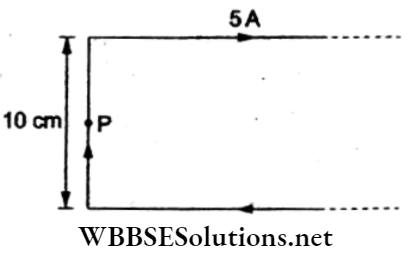
- 10-2 N m-1
- 3 x 10-4 N m-1
- 0.3 N m-1
- 10-4 N m-1
Answer: 4. 10-4 N m-1
The magnetic field at P due to each semi-infinite straight wire is \(\frac{\mu_0 I}{4 \pi d}\) directed into the plane of the paper. Hence, thenet field atP is B = \(\frac{\mu_0 I}{2 \pi d}\).
Force per unit length is
\(\frac{\Delta F}{\Delta l}=B I=\frac{\mu_0 I^2}{2 \pi d}=\frac{\left(2 \times 10^{-7} \cdot \mathrm{H} \mathrm{m}^{-1}\right)(5 \mathrm{~A})^2}{\left(5 \times 10^{-2} \mathrm{~m}\right)}=10^{-4} \mathrm{~N} \mathrm{~m}^{-1}\).
Question 71. Find the magnetic field at the center P of a square loop with each side of length 20 cm.
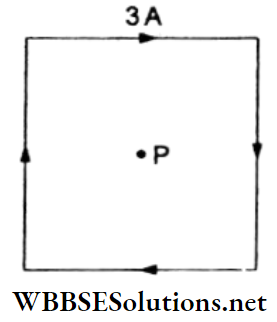
- 122 x l0-6 T
- 6 x 10-4 T
- 12 x l0-6 T
- 62 x l0-6 T
Answer: 1. 122 x l0-6 T
The field at P due to each straight current is
⇒ \(B_{\mathrm{P}}=\frac{\mu_0}{4 \pi} \frac{I}{d}\left(\sin 45^{\circ}+\sin 45^{\circ}\right)=\frac{\mu_0 I}{4 \pi d} \cdot \frac{2}{\sqrt{2}}(\text { directed inward })\).
The net field at the center is
∴ \(B=4 B_{\mathrm{P}}=\frac{\mu_0 I}{4 \pi d} \cdot \frac{8}{\sqrt{2}}=\frac{\left(10^{-7} \mathrm{H} \mathrm{m}^{-1}\right)(3 \mathrm{~A}) 8}{\left(10 \times 10^{-2} \mathrm{~m}\right) \sqrt{2}}=12 \sqrt{2} \times 10^{-6} \mathrm{~T}\).
Question 72. Two coaxial circular loops having the same radius R=10 cm have the same current I = 3.5 A flowing through them. If the separation between their centers is 10 cm, find the magnitude of the net magnetic field at point P.
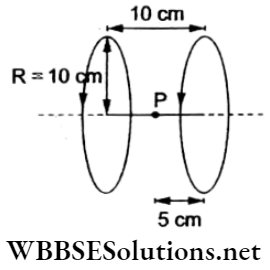
- \(\frac{50 \mu_0}{\sqrt{5}} \mathrm{~T}\)
- \(\frac{20 \mu_0}{\sqrt{5}} \mathrm{~T}\)
- \(\frac{56 \mu_0}{\sqrt{5}} \mathrm{~T}\)
- \(\frac{50 \mu_0}{\sqrt{3}} \mathrm{~T}\)
Answer: 3. \(\frac{56 \mu_0}{\sqrt{5}} \mathrm{~T}\)
The magnetic field at P due to each circular current loop will have the same magnitude and the same direction (towards the right) so the fields add up.
Hence, the net field is
⇒ \(B=2 \frac{\mu_0 I R^2}{2\left(R^2+x^2\right)^{3 / 2}}, \text { where } I=3.5 \mathrm{~A}, R=10 \mathrm{~cm}, x=5 \mathrm{~cm} \text {. }\).
∴ \(B=\frac{\mu_0(3.5 \mathrm{~A})\left(10 \times 10^{-2} \mathrm{~m}\right)^2}{\left[\left(10^{-1} \mathrm{~cm}\right)^2+\left(0.5 \times 10^{-1} \mathrm{~m}\right)^2\right]^{3 / 2}}=\frac{56 \mu_0}{\sqrt{5}} \mathrm{~T}\).
Question 73. The currents through two parallel wires are I2 with I1>I2. When the currents are in the same direction, the magnetic field at a point midway between the wires is 10T. If the direction of the current is reversed in one of the wires, the magnetic field becomes 30 μT The ratio I1/I2 is
- 1
- 2
- 3
- 4
Answer: 2. 2
When the currents are in the same direction,
⇒ \(B_1=\frac{\mu_0\left(I_1-I_2\right)}{2 \pi d}=10 \mu \mathrm{T}\)
When the currents flow in opposite directions,
⇒ \(B_2=\frac{\mu_0\left(I_1+I_2\right)}{2 \pi d}=30 \mu \mathrm{T}\)
∴ \(\frac{I_1+I_2}{I_1-I_2}=\frac{3}{1} \Rightarrow \frac{I_1}{I_2}=2\)
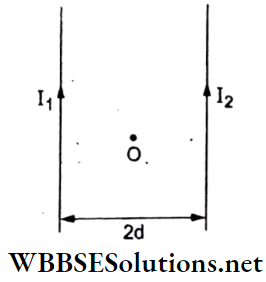
Question 74. A thin ring of radius 10 cm carries a uniformly distributed charge. The ring rotates at a constant angular speed of 40K rad s-1 about its axis, perpendicular to its plane. If the magnetic field at its center is 3.8 x 10-9 T then the charge carried by the ring is close to (given that μ0 = 4n x 10-7 N A-2 )
- 3 x 10-5 C
- 2 x 10-6 C
- 4 x 10-5 C
- 7 x 10-6 C
Answer: 1. 3 x 10-5 C
A revolving circular coil with charge Q and time period T is equivalent to a current I = \(=\frac{Q}{T}=\frac{Q \omega}{2 \pi}\)
It produces a magnetic field B at the center, where
⇒ \(B=\frac{\mu_0 I}{2 R}=\frac{\mu_0 Q_\omega}{4 \pi R}\)
⇒ \(Q=\frac{4 \pi R \cdot B}{\mu_0 \omega}=\frac{4 \pi\left(10 \times 10^{-2} \mathrm{~m}\right)\left(3.8 \times 10^{-9} \mathrm{~T}\right)}{\left(4 \pi \times 10^{-7} \mathrm{~N} \mathrm{~A}^{-2}\right)\left(40 \pi \mathrm{rad} \mathrm{s}^{-1}\right)}\)
∴ \(\frac{3.8}{4 \pi} \times 10^{-4} \mathrm{C} \approx 3.0 \times 10^{-5} \mathrm{C}\).
Question 75. Two straight wires A and B carrying steady current I1 and I2 as shown in the figure have a separation d between them. A third wire C carrying a steady current I is to be placed parallel to them at a distance x from A such that the net force acting on it is zero. The possible values of x are
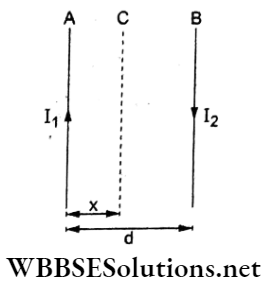
- \(x=\left(\frac{I_2}{I_1+I_2}\right) d \text { and } x=\left(\frac{I_2}{I_1-I_2}\right) d\)
- \(x=\left(\frac{I_1}{I_1-I_2}\right) d \text { and } x=\left(\frac{I_2}{I_1+I_2}\right) d\)
- \(x= \pm \frac{I_1 d}{\left(I_1-I_2\right)}\)
- \(x=\left(\frac{I_1}{I_1+I_2}\right) d \text { and } x=\left(\frac{I_2}{I_1-I_2}\right) d\)
Answer: 3. \(x= \pm \frac{I_1 d}{\left(I_1-I_2\right)}\)
The third wire C will never experience zero force when lying between five two wires A and B carrying currents I1 and I2 in opposite directions. Let C be placed at a distance x to the left of A. The forces due to I1 and I2 will be in opposite directions leading to zero net force. Hence,
⇒ \(\frac{\mu_0 I_1 I}{2 \pi x}=\frac{\mu_0 I_2 I}{2 \pi(d+x)} \Rightarrow x=\frac{I_1 d}{I_2-I_1}=-\frac{I_1 d}{I_1-I_2}\).
When C is placed to the right of B at a distance x from A then
⇒ \(\frac{\mu_0 I_1 I}{2 \pi x}=\frac{\mu_0 I_2 I}{2 \pi(x-d)} \Rightarrow x=\frac{I_1 d}{I_1-I_2}\).
∴ \(\text { Hence, } x= \pm\left(\frac{I_1 d}{I_1-I_2}\right)\).
Question 76. A proton, an electron, and a helium nucleus have the same energy in circular motion in a plane due to a magnetic field perpendicular to the plane. If rp, re and rHe are their respective radii then
- \(r_{\mathrm{e}}>r_{\mathrm{p}}=r_{\mathrm{He}}\)
- \(r_{\mathrm{e}}>r_{\mathrm{p}}>r_{\mathrm{He}}\)
- \(r_{\mathrm{e}}<r_{\mathrm{p}}<r_{\mathrm{He}}\)
- \(r_{\mathrm{e}}<r_{\mathrm{p}}=r_{\mathrm{He}}\)
Answer: 4. \(r_{\mathrm{e}}<r_{\mathrm{p}}=r_{\mathrm{He}}\)
For a charged particle moving in a magnetic field, the centripetal force is
⇒ \(F=q v B=\frac{m v^2}{r}\)
Momentum = p = mv = qBr,
⇒ The KE = E = \(\frac{p^2}{2 m}=\frac{q^2 B^2 r^2}{2 m} \Rightarrow r^2 \propto \frac{m}{q^2}\)
Since E is the same for p, e, and He+,
⇒ \(r_{\mathrm{p}}^2: r_{\mathrm{e}}^2: r_{\mathrm{He}}^2=\frac{m_{\mathrm{p}}}{e^2}: \frac{m_{\mathrm{e}}}{e^2}: \frac{4 m_{\mathrm{p}}}{(2 e)^2}\)
⇒ latex]r_{\mathrm{p}}: r_{\mathrm{e}}: r_{\mathrm{He}}=\sqrt{m_{\mathrm{p}}}: \sqrt{m_{\mathrm{e}}}: \sqrt{m_{\mathrm{p}}}[/latex]
∴ rp < re = rHe.
Question 77. A current loop having two circular arcs joined by two radial lines is shown in the figure. It carries a steady current of 10 A. The magnetic field at point O will be close to [Take θ = 45°]
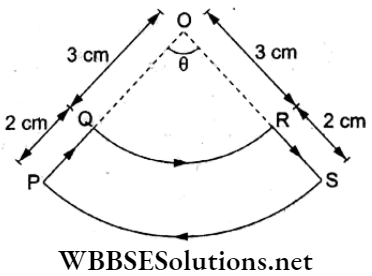
- 1.6 x 10-5 T
- 1.0 X 10-7 T
- 1.5 x 10-7 T
- 1.5 x 10-5 T
Answer: 1. 1.6 x 10-5 T
The magnetic field at O due to element SP is
⇒ \(B_1=\frac{1}{8} \frac{\mu_0 I}{2 R_1}\)
⇒ (directed into the plane) and due to element QR, \(B_2=\frac{1}{8} \frac{\mu_0 I}{2 R_2}\) (directed outward).
∴ net field = B = B2 – B1 = \(\frac{\mu_0}{1 \times 4}\left(\frac{I}{R_2}-\frac{I}{R_1}\right)\)
⇒ \(\frac{\pi}{4} \times\left(10^{-7} \mathrm{H} \mathrm{m}^{-1}\right)\left(\frac{10 \mathrm{~A}}{3 \times 10^{-2} \mathrm{~m}}-\frac{10 \mathrm{~A}}{5 \times 10^{-2} \mathrm{~m}}\right)\)
∴ \(\frac{\pi 10^{-5}}{4}\left(\frac{20}{15}\right) \mathrm{T}=\frac{\pi}{3} \times 10^{-5} \mathrm{~T} \approx 1 \times 10^{-5} \mathrm{~T}\).
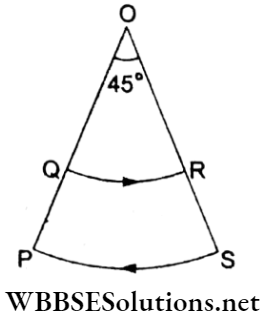
Question 78. An insulated thin rod of length l has a linear charge density \(\rho(x)=\rho_0 \frac{x}{l}\) on it. The rod is rotated about an axis passing through the origin (x = 0) and perpendicular to the rod, making η rps. The time-averaged magnetic moment of the rod is
- \(\eta \rho_0 l^3\)
- \(\pi \eta \rho_0 l^3\)
- \(\frac{\pi}{3} \eta \rho_0 l^3\)
- \(\frac{\pi}{4} \eta \rho_0 l^3\)
Answer: 4. \(\frac{\pi}{4} \eta \rho_0 l^3\)
The element of length dr at a distance r from O contains charge
⇒ \(d Q=\rho(r) d r=\rho_0 \frac{r}{l} d r\)
The circular motion of this charges electric current
⇒ \(I=\frac{d Q}{T}=(d Q) f=\frac{\eta \rho_0 r d r}{l}\)
Where frequency f = ηrps
The equivalent magnetic moment will be
⇒ \(d m=L A=\frac{n \rho_0 r d r}{l} \cdot \pi r^2\)
Net magnetic momentis
∴ \(m=\int d m=\frac{\pi}{l} \eta \rho_0 \int_0^l r^3 d r=\frac{\pi}{4} \eta \rho_0 l^3\)
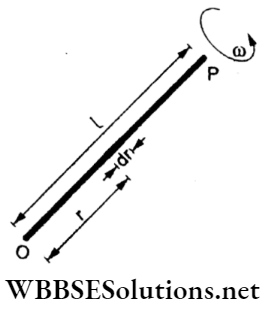
Question 79. One of two conducting wires of length L is bent in the form of a circular loop and a circular coil of N identical turns is formed from the other. If the same current is passed through, the ratio of the magnetic field at the center of the loop to that at the center of the coil will be
- \(\frac{1}{N}\)
- N
- \(\frac{1}{N^2}\)
- N2
Answer: 3. N2
The magnetic field at the center of the current-carrying circular coil is \(B=\frac{\mu_0 N I}{2 R}\)
In case(1),
\(N_1=1, R=\frac{L}{2 \pi}\)∴ \(B_1=\frac{\mu_0 I}{2 L / 2 \pi}=\frac{\mu_0 \pi I}{L}\)
In case (2),
\(N_2=N, R_2=\frac{L}{2 \pi N}\)∴ \(B_2=\frac{\mu_0 I N}{2 L / 2 \pi N}=\frac{\mu_0 \pi I N^2}{L}\)
⇒ \(\frac{B_1}{B_2}=\frac{\mu_0 \pi I}{L} \times \frac{L}{\mu_0 I N^2 \pi}=\frac{1}{N^2}\).
Question 80. A particle of mass m and charge q is in a region containing
\(\vec{E}=(2 \hat{i}+3 \hat{j}) \mathrm{V} \cdot \mathrm{m}^{-1}\) and \(\vec{B}=(4 \hat{j}+6 \hat{k}) \mathrm{T}\) T. The charged particle is shifted from the origin to the point P(l, 1) along a straight path. The magnitude of the total work done is
- 5q
- (2.5)q
- (0.35)4
- (0.15)4
Answer: 1. 5q
When a charged particle enters a region containing \(\vec{E}[latex] and [latex]\vec{B}[latex], work is done only by the electric field.
Thus, W = [latex]\vec{F} \cdot \overrightarrow{d r}=q \vec{E} \cdot \overrightarrow{d r}\)
⇒ \(q(2 \hat{i}+3 \hat{j}) \cdot(\hat{i}+\hat{j})\)
∴ q (2+3) = 5q J.
Question 81. Two infinitely long identical wires are bent at 90° and placed in such a way that the segments LP and QM are along the x-axis, while segments PS and QN are parallel to the y-axis. If OP = OQ = 4cm the magnitude of the magnetic field at O is 10-4 T and the two wires carry equal currents, the magnitude of the current in each wire and the direction of the magnetic field at O will
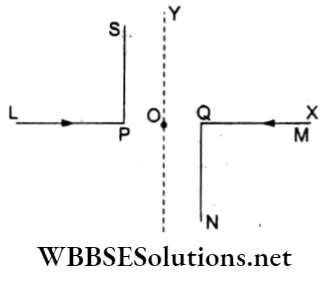
- 40 A, perpendicularly out of the page
- 20 A, perpendicularly into the page
- 20 A, perpendicularly out of the page
- 40 A, perpendicularly into the page
Answer: 2. 20 A, perpendicularly into the page
Since O lies on the x-axis, currents along the x-axis will not contribute to the magnetic field at O. The field due to the current along the y-axis at O is \(\frac{1}{2}\left(\frac{\mu_0 I}{2 \pi d}\right)\) due to each wire.
The net magnetic field at O will be
⇒ \(B_0=2\left(\frac{1}{2} \frac{\mu_0 I}{2 \pi d}\right)=10^{-4} \mathrm{~T} \quad \text { (given) }\)
⇒ \(2\left(10^{-7} \mathrm{H} \mathrm{m}^{-1}\right) \frac{I}{\left(4 \times 10^{-2} \mathrm{~m}\right)}=10^{-4} \mathrm{~T}\).
∴ \(I=2 \times 10 \mathrm{~A}=20 \mathrm{~A}, \vec{B}_0\) is directed into theplane of the paper.
Question 82. Two very long, straight, and insulated wires are kept at 90° with each other in the xy-plane as shown in the figure. These wires carry currents of equal magnitude. I, whose directions are shown in the figure. Thenetmagnetic field at point P will be
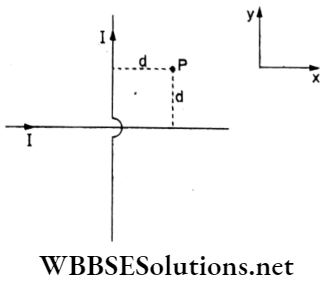
- \(\frac{\mu_0 I}{2 \pi d}(\hat{x}+\hat{y})\)
- \(-\frac{\mu_0 I}{2 \pi d}(\hat{x}+\hat{y})\)
- Zero
- \(\frac{\mu_0 I}{\pi d}\)
Answer: 3. Zero
The magnetic field at P due to the current along the x-axis s given by
⇒ \(\vec{B}_1=\frac{\mu_0}{2 \pi} \frac{I}{d}(+\hat{k})\)
and that due to the current along the they-axis is
⇒ \(\vec{B}_2=\frac{\mu_0}{2 \pi} \frac{I}{d}(-\hat{k})\)
∴ \(\vec{B}=\vec{B}_1+\vec{B}_2=0\).
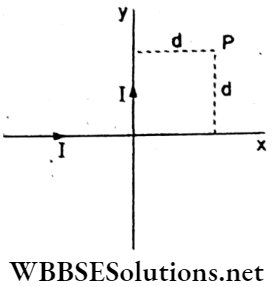
Question 83. A conducting square loop carrying a steady current I has a magnitude of magnetic dipole moment. If the shape of this square loop is changed to circular and the current I remains unchanged, the magnitude of the dipole moment of the circular loop will be
- \(\frac{m}{\pi}\)
- \(\frac{4 m}{\pi}\)
- \(\frac{3 m}{\pi}\)
- \(\frac{2 m}{\pi}\)
Answer: 2. \(\frac{4 m}{\pi}\)
The magnetic moment of a current loop is
m = IA = I(a2), where a = side of square
When shaped into a circle, 4a= 2πR
⇒ \(R=\frac{2 a}{\pi} \text { and area } \pi R^2=\frac{4 \pi a^2}{\pi^2}\)
⇒ resultant magnetic moment
∴ \(m^{\prime}=I\left(\pi R^2\right)=\left(I a^2\right)\left(\frac{4}{\pi}\right)=\frac{4 m}{\pi}\).
Question 84. The magnitude of the magnetic field at the centroid of an equilateral triangular loop of side 1 m which is carrying a steady current of 10 A is
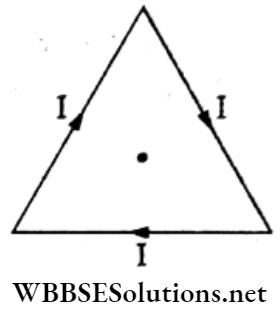
- 3 μT
- 1 μT
- 18 μT
- 9 μT
Answer: 3. 18 pT
The magnetic field at the centroid of the equilateral triangle due to each of its sides will be the same(= B0 ) and directed into the plane of the paper.
From ΔOQN, \(\frac{Q N}{O N}=\tan 60^{\circ}=\sqrt{3}\)
⇒ \(O N=d=\frac{1}{2 \sqrt{3}}\)
The magnetic field at O due to side QR,
⇒ \(B_0=\frac{\mu_0 I}{4 \pi d}\left[\sin 60^{\circ}+\sin 60^{\circ}\right]\)
⇒ \(\frac{10^{-7}(10 \mathrm{~A}) \sqrt{3}}{\left(\frac{1}{2 \sqrt{3}} \mathrm{~m}\right)} \mathrm{T}=60 \times 10^{-7} \mathrm{~T}\)
Net field= 3 B0 =180 x 10-7 T = 18 μT.
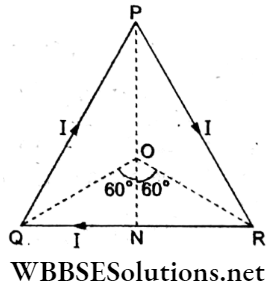
Question 85. Find the magnetic field at point P due to a straight line segment AB of length 6 cm carrying a steady current of 5 A.
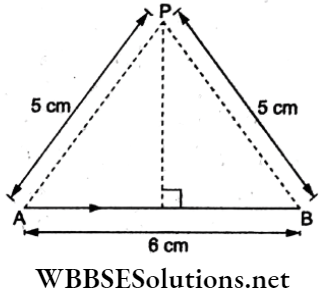
- 3.0 x 10-5 T
- 2.0 x 10-5 T
- 2.5 x 10-5 T
- 1.5 x 10-5 T
Answer: 4. 1.5 x 10-5 T
Due to line segment AB, the magnetic field at P will be
⇒ \(B=\frac{\mu_0}{4 \pi} \frac{I}{d}(\sin \theta+\sin \theta)\)
∴ \(\left(10^{-7} \mathrm{H} \mathrm{m}^{-1}\right) \frac{(5 \mathrm{~A})}{\left(4 \times 10^{-2} \mathrm{~m}\right)}\left[\frac{3}{5}+\frac{3}{5}\right]=1.5 \times 10^{-5} \mathrm{~T}\).
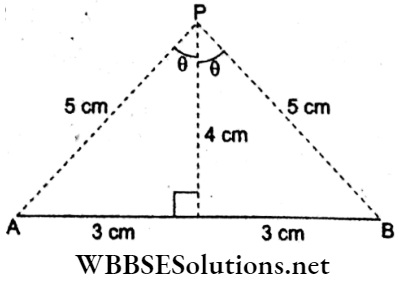
Question 86. A proton moving at 10 m s-1 enters a uniform magnetic field of 2.0 mT, making an angle of 60° with the direction of the magnetic field. Find the pitch of its spiral trajectory.
- 30 πm
- 50 πm
- 80 μπm
- l0 μπm
Answer: 3. 80 μπm
The helical path followed by the proton has time period T \(\frac{2 \pi m}{q B}\) and the proton moves forward with velocity component \(v_{\|}=v \cos \theta\).
∴ pitch = \((v \cos \theta) \frac{(2 \pi m)}{q B}\)
⇒ \(\frac{\left(10 \mathrm{~m} \mathrm{~s}^{-1}\right)\left(\cos 60^{\circ}\right)(2 \pi)\left(1.6 \times 10^{-27} \mathrm{~kg}\right)}{\left(1.6 \times 10^{-19} \mathrm{C}\right)\left(2 \times 10^{-3} \mathrm{~T}\right)}\).
⇒ 5n x 10-5 m = 50π μm.
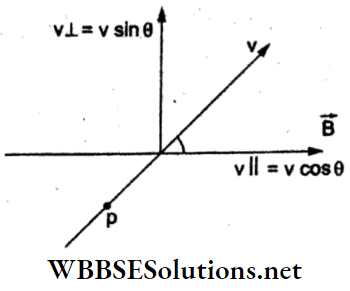
Question 87. A square loop of side 2a carrying a steady current I is kept in the xz-plane with its center at the origin. A long wire carrying the same Steady current I is placed parallel to the z-axis and passes through the point (0, h, 0), where b » a. The magnitude of the torque on the loop about the z-axis will be
- \(\frac{\mu_0 I^2 a^2 b}{2 \pi\left(a^2+b^2\right)}\)
- \(\frac{\mu_0 I^2 a^2}{2 \pi b}\)
- \(\frac{2 \mu_0 I^2 a^2}{\pi b}\)
- \(\frac{2 \mu_0 I^2 a^2 b}{\pi\left(a^2+b^2\right)}\)
Answer: 3. \(\frac{2 \mu_0 I^2 a^2}{\pi b}\)
The magnetic moment of the current loop is \(\vec{m}\) = (A I) \hat{j}=\left(4 a^2 I\right) \hat{j}
The magnetic field due to a straight current at a distance b (around the current loop and in its plane) is
⇒ \(\vec{B}=\left(\frac{\mu_0 I}{2 \pi b}\right) \hat{i}\).
∴ Torque = \(|\vec{\tau}|=|\vec{m} \times \vec{B}|=\left(4 a^2 I\right)\left(\frac{\mu_0 I}{2 \pi b}\right)=\frac{2 \mu_0 I^2 a^2}{\pi b}\).
Question 88. A charged particle of mass m having charge q is undergoing uniform circular motion in a uniform magnetic field. It equivalent magnetic moment is
- \(-\frac{m v^2}{B^2} \vec{B}\)
- \(-\frac{m v^2}{2 B^2} \vec{B}\)
- \(-\frac{m v^2}{2 \pi B^2} \vec{B}\)
- \(\frac{m v^2}{2 B^2} \vec{B}\)
Answer: 2. \(-\frac{m v^2}{2 B^2} \vec{B}\)
Let the charged particle moving with a speed v describe anticlockwise a circular path in \(\vec{B}\) field directed inward.
Magnetic force \(q|(\vec{v} \times \vec{B})|=\frac{m v^2}{r}\).
Orbital Radius \(r=\frac{m v}{q B}\) and frequency
⇒ \(f=\frac{1}{T}=\frac{q B}{2 \pi m}\).
Hence, equivalent current is I = \(=\frac{q}{T}=\frac{q^2 B}{2 \pi m}\).
⇒ Magnetic momentis \(\mu=L A=\frac{q^2 B}{2 \pi m} \pi\left(\frac{m v}{q B}\right)^2=\frac{m v^2}{2 B}\).
Since the current is anticlockwise, the magnetic moment is directed outward (against \(\vec{B}\)).
∴ Hence, \(\vec{\mu}=\frac{m v^2}{2 B}(-\hat{B})=-\frac{m v^2}{2 B^2} \vec{B}\).
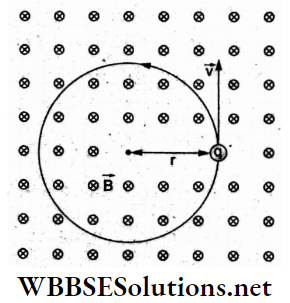
Question 89. A regular hexagonal loop of side 10 cm and a total of 50 turns carries a steady current I. The magnetic field at the center O in units of \(\frac{\mu_0 I}{\pi}\) is
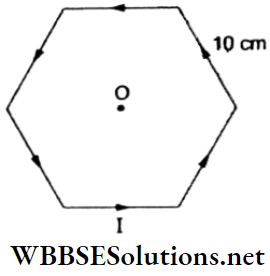
- 2503
- 500√3
- 3003
- 4003
Answer: 2. 500√3
The magnetic field at the center O due to each side of the hexagon is given by
⇒ \(B_0=\frac{\mu_0 I}{4 \pi d}\left(\sin 30^{\circ}+\sin 30^{\circ}\right) 50\)
⇒ \(\frac{\mu_0 I 50}{4 \pi a \frac{\sqrt{3}}{2}}=\frac{\mu_0 I}{\pi}\left(\frac{50}{2 a \sqrt{3}}\right)\)
∴ Total field = B = \(6 B_0=\frac{\mu_0 I}{\pi}\left(\frac{6 \sqrt{3} \times 50}{6 \times 10 \times 10^{-2} \mathrm{~m}}\right) \mathrm{T}=\frac{\mu_0 I}{\pi}(500 \sqrt{3}) \mathrm{T}\)
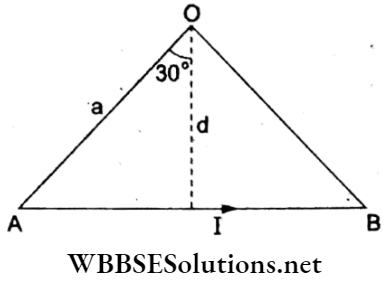
Question 90. A particle carrying charge 1|iC moves with a velocity \(\vec{v}=(4 \hat{i}+6 \hat{j}+3 \hat{k}) \mathrm{m} \mathrm{s}^{-1}\) in a uniform magnetic field of \((3 \hat{i}+4 \hat{j}-3 \hat{k}) \mathrm{mT}\). The force exerted on the charged particle in units of 10-9 N is
- \(-0.3 \hat{i}+2.1 \hat{j}+0.4 \hat{k}\)
- \(-3 \hat{i}+0.21 \hat{j}+0.4 \hat{k}\)
- \(-30 \hat{i}+21 \hat{j}-2 \hat{k}\)
- \(-0.3 \hat{i}+0.21 \hat{j}+0.04 \hat{k}\)
Answer: 3. \(-30 \hat{i}+21 \hat{j}-2 \hat{k}\)
The force on a moving charge in a magnetic field,
\(\vec{F}=q(\vec{v} \times \vec{B})=q\left|\begin{array}{ccc}\hat{i} & \hat{j} & \hat{k} \\
4 & 6 & 3 \\
3 & 4 & -3
\end{array}\right|\)
⇒ \(q[(-18-12) \hat{i}+(9+12) \hat{j}+(16-18) \hat{k}]\)
⇒ \(\left(10^{-6} \mathrm{C}\right)(-30 \hat{i}+21 \hat{j}-2 \hat{k}) \mathrm{mT} \mathrm{m} \mathrm{s}^{-1}\).
⇒ \(10^{-9}(-30 \hat{i}+21 \hat{j}-2 \hat{k}) \mathrm{N}\).
Question 91. Conducting wires in the form of two concentric circular arcs of radii R1 and R2 carrying a steady current of 2 A are shown in the figure. The ratio of magnetic fields \(\frac{B_1}{B_2}\) produced by them at the center is
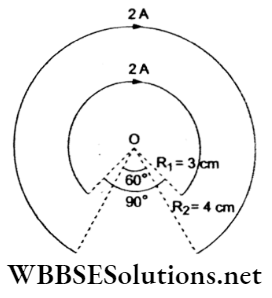
- \(\frac{5}{6}\)
- \(\frac{6}{5}\)
- \(\frac{3}{4}\)
- \(\frac{4}{3}\)
Answer: 2. \(\frac{6}{5}\)
The magnetic field at the centre of the circular arcs subtending an angle of 0 at the centre will be
⇒ \(B=\frac{\mu_0 I}{2 R} \frac{\theta}{2 \pi}=\frac{\mu_0 I \theta}{4 \pi R}\)
The field at O due to the inner arc is
⇒ \(B_1=\frac{\mu_0 I_1}{4 \pi R_1}\left(2 \pi-\frac{\pi}{2}\right)=\frac{3 \mu_0 I_1}{8 R_1}\)
and that due to the outer arc is
⇒ \(B_2=\frac{\mu_0 I_2}{4 \pi R_2}\left(2 \pi-\frac{\pi}{3}\right)=\frac{5 \mu_0 I_2}{12 R_2}\)
∴ ratio = \(\frac{B_1}{B_2}=\frac{3}{8} \times \frac{12}{5} \times \frac{I_1}{I_2} \times \frac{R_2}{R_1}=\frac{9}{10} \times\left(\frac{2 \mathrm{~A}}{2 \mathrm{~A}}\right) \times\left(\frac{4 \mathrm{~cm}}{3 \mathrm{~cm}}\right)=\frac{6}{5}\).
